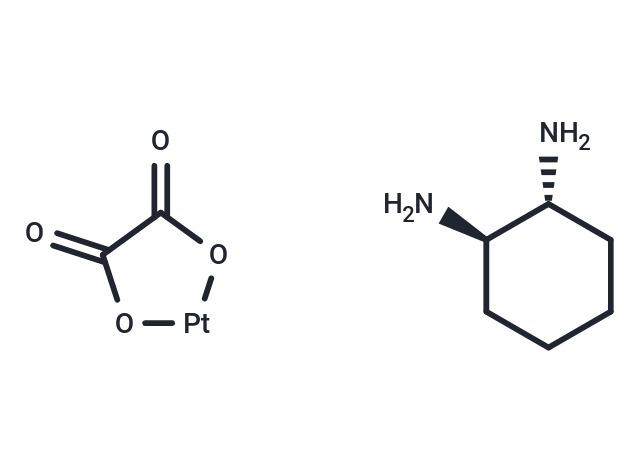Shopping Cart
- Remove All
 Your shopping cart is currently empty
Your shopping cart is currently empty

Oxaliplatin (L-OHP) is a DNA alkylating agent, an inhibitor of DNA synthesis. Oxaliplatin causes DNA cross-linking damage, preventing DNA replication and transcription and leading to cell death. Oxaliplatin induces autophagy.

| Pack Size | Price | Availability | Quantity |
|---|---|---|---|
| 50 mg | $50 | In Stock | |
| 100 mg | $68 | In Stock | |
| 200 mg | $117 | In Stock | |
| 500 mg | $139 | In Stock |
| Description | Oxaliplatin (L-OHP) is a DNA alkylating agent, an inhibitor of DNA synthesis. Oxaliplatin causes DNA cross-linking damage, preventing DNA replication and transcription and leading to cell death. Oxaliplatin induces autophagy. |
| In vitro | Oxaliplatin is effective against intracerebrally implanted L1210 leukemia, MA 16-C transplantable tumors, B16 melanoma transplantable tumors, Lewis lung carcinoma transplantable tumors, and C26 colon carcinoma transplantable tumors. Intraperitoneal administration of 10 mg/kg Oxaliplatin weekly in nude mice bearing HCCLM3 hepatic tumor significantly reduces tumor volume and increases apoptotic index. In mice, Oxaliplatin induces a decrease in regressive neuroconduction. |
| In vivo | Oxaliplatin exhibits potent inhibitory effects on various cancer cell lines, including bladder cancer (RT4 and TCCSUP), ovarian cancer (A2780), colorectal cancer (HT-29), glioblastoma (U-373 mg and U-87 mg), and melanoma (SK-MEL-2 and HT-144), with respective IC50 values of 11 μM, 15 μM, 0.17 μM, 0.97 μM, 2.95 μM, 17.6 μM, 30.9 μM, and 7.85 μM. Additionally, oxaliplatin effectively suppresses human melanoma cell lines C32 and G361, with IC50 values of 0.98 mM and 0.14 mM, respectively. |
| Kinase Assay | Binding experiments of electrophysiology: CHO cells expressing the subunit of the voltage-dependent L-type Ca2+ channel are cultrured in medium without serum in the presence of different concentrations of Nisoldipine. Then Ca2+ channel current elicited from a holding potential of -100 mV or -50 mV is recorded at room temperature with the whole-cell configuration of the patch-clamp method using the List EPC-7 patch-clamp amplifer and pClamp software. The concentration of competitor inhibiting 50% of the specific binding represents IC50. |
| Cell Research | The cytotoxicity studies are carried out with the sulforhodamine-B microculture colorimetrie assay. Typically, cells are plated into 96-well plates on day 0 and exposed to Oxaliplatin on day 1; the sulforhodamine-B assay is carried out 48 h after Oxaliplatin exposure. The plates are incubated at 37 °C in 5% CO2 and 100% relative humidity at all times except when adding Oxaliplatin and during the final assay period. The initial number of cells plated for the assay ranged from 2-20 × 103 cells/50 /nL/well. The numbers of cells for plating and the drug exposure time are based on pilot studies using the criteria that (a) the cells in control wells are still in the log phase of growth on the day of the assay; (b) the maximum absorbance for the untreated controls on the day of the assay is in the range of 1.0 to 1.5; and (c) cells go through >2 doublings during the drug exposure. Eight wells are used per concentration. The plates are read at 570 and/or 540 nm using a Biotek Instruments model EL309 microplate reader interfaced with an IBM PC-compatible computer. The data are transferred and transformed into a LOTUS 1-2-3 format by the computer program DATALOG, and survival fractions are calculated by comparing the drug treated with control(Only for Reference) |
| Alias | L-OHP |
| Molecular Weight | 397.29 |
| Formula | C8H14N2O4Pt |
| Cas No. | 61825-94-3 |
| Smiles | O=C1O[Pt]OC1=O.N[C@@H]1CCCC[C@H]1N |
| Relative Density. | no data available |
| Storage | keep away from direct sunlight | Powder: -20°C for 3 years | In solvent: -80°C for 1 year | Shipping with blue ice. | |||||||||||||||||||||||||||||||||||||||||||||
| Solubility Information | Ethanol: < 1 mg/mL (insoluble) DMSO: 50 mg/mL (125.85 mM), DMSO inactivates the activity of Oxaliplatin. H2O: 3.33 mg/mL (8.38 mM), Sonication is recommended. DMF: 1.67 mg/mL (4.20 mM), Sonication is recommended. | |||||||||||||||||||||||||||||||||||||||||||||
Solution Preparation Table | ||||||||||||||||||||||||||||||||||||||||||||||
DMF/H2O/DMSO
H2O/DMSO
DMSO
| ||||||||||||||||||||||||||||||||||||||||||||||

Copyright © 2015-2025 TargetMol Chemicals Inc. All Rights Reserved.